The Geometric Period
1/48
There's no tags or description
Looks like no tags are added yet.
Name | Mastery | Learn | Test | Matching | Spaced |
|---|
No study sessions yet.
49 Terms
Geometric Period
900-700 BC
Split in 3 Parts
Early Geometric: (900-850)
Middle Geometric: (850-750)
Late Geometric: (750-690)
Late Geometric I 750-730
Late Geometric II
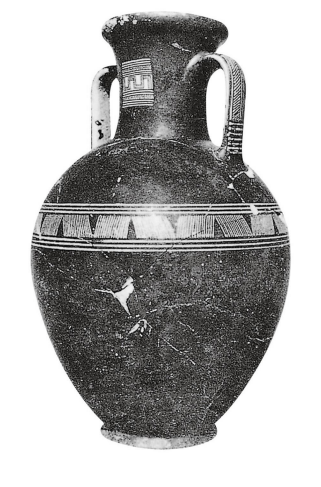
Attic neck-handled amphora
was used for male cremation urn
minimal geometric design
Early Geometric Pottery
900-850
light on dark
minimal geometric design
Introduction of meander
Meander
A repetitive decorative pattern found on pottery
represents concepts of infinity
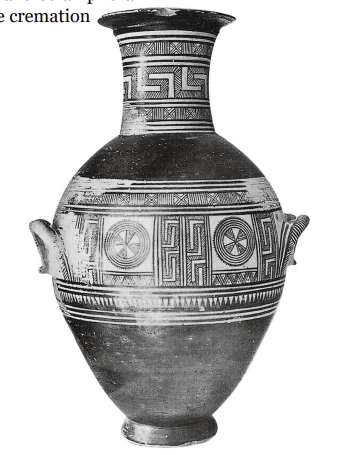
Middle Geometric Period
850-750 BC
greater elaborative design
Meander is the focus
Light on dark
focus on geometric pattern more intense
pyxis
a cosmetic box
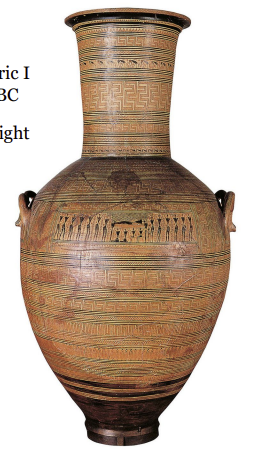
Late Geometric Period I
750-730 BC
Dipyleon Gate and Karameikos Cemetary
The main gate outside Athens
Cemetery around the walls of Athens

Dipyleon Amphora
worked as grave markers
Late Geometric
5’ 1”
c. 750 BC
When the establishment of the first cities began
made by the dipyleon master
female grave marker
belly handle
marked an inhumation burial
Likely for an aristocratic woman
Marks the existence of the aristocratic class
was a world where there were influential and wealthy women
Decoration on the Dipyleon Amphora
meander
zigzags
chevrons → These designs would be everywhere
lozenges
concentric bands
Humans
the 8th century is the first time that the human form reappears in art.
gazelles
horses
goats
ducks
*Prothesis
8th century
the 8th century is the first time that the human form reappears in art.
the 8th cent was a Renaissance period
colonization, reemergence of writing and art, establishment of literature, philosophical development, the emergence of the state
a desire for order and patterns
The State supersedes the powers of families who were the dominant
forces before.
Prothesis
laying of the deceased
Prothesis on the Dipyleon Amphora
the men are depicted as naked, the women are clothed
There is a shroud wrapped around the deceased
women kneeling
men seated and standing
are all pulling at their heads as if they are pulling out their hair
Burial in the Geometric Period
In the 8th century, there were both inhumation and cremation burials
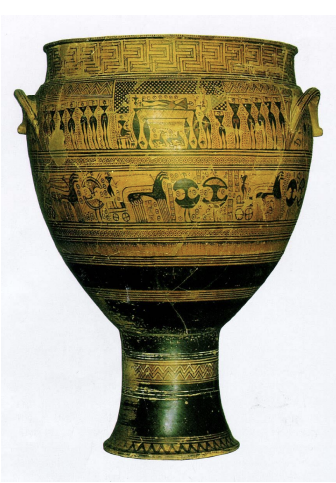
Dipyleon Krater
Dipylon Krater
Late Geometric
4’
c. 750 BC
Symposium vessel
Male grave marker
depicts a prothesis as a well an Ekphora
there are soldiers using figure 8 Shields, but people from this time wouldn't know about the Mycenaean
So likely a reference to Homer
This krater could depict a Homeric scene
ekphora
a funeral procession
symposium
an event for men to eat, drink, and discuss topics concerning military, philosophy, society, and mythology
sometimes high-class prostitutes would be present and participate
Development of Athenian cremation burials over time
10th-9th century (cinerary urns)
Men : Neck-handled
women : Belly handle
8th century (grave markers)
Men : Krater
Women : Belly handle

Krater
760-735 BC, Late Geometric I
depicts combat on a ship
has a mythological reference
Jason and the Argonauts?
Trojan War?
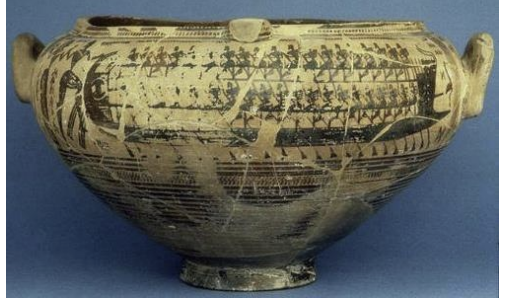
Krater, Thebes
730 BC
Paris abducting Helen?
was a symposium vessel
These painted images would be points of conversation

Neck-handled Amphora
Late Geometric II (730-690 BC)
Depicts
mourners, warriors, and horses
snakes on the shoulder
Repetitive patterns are now mixed in with wavy lines

Ionian “bird bowl”
625 BC
“Subgeometric style” continues into the 7th century
Human form reappears in art
Reinvention of writing
- earliest authors: Homer, Hesiod
Polis, c. 800 BC - all burials extramural; communal cemeteries → previously they were family plots
It was illegal for them to take place in the city
This was how they were able to identify the beginning of the polis
Rise in population → signals economic prosperity
Colonization (Korkyra; Syracuse; Magna Graecia)
There was land hunger
Formalization of religious centers (sanctuaries)
Panhellenic sanctuaries (Olympia, Delphi)
Rule largely by elite: aristocracies/ oligarchies
Trade increases (bronze reappears)
Hero cults flourish
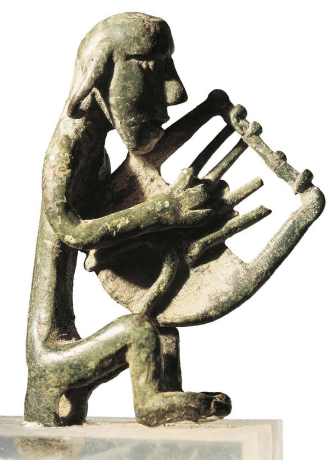
Syrian-Cretan bronze lyre-player
Crete
8th century BC
could be a bard singing Homeric epics or Apollo
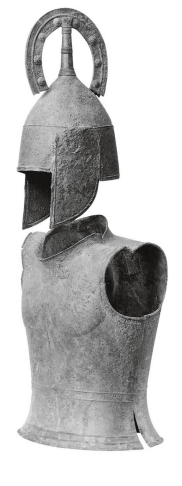
Bronze armor from a “heroic” burial at Argo
late 8th century BC
The helmet resembles those worn by soldiers of the Assyrian Empire
demonstrates that the near east is stimulating a lot of these developments
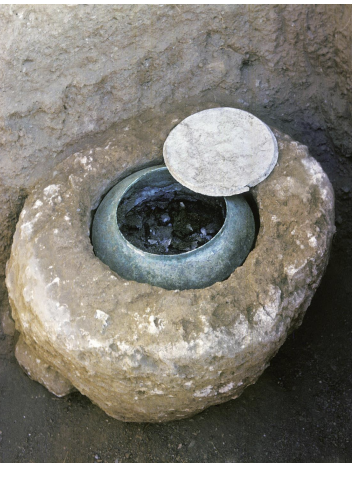
Bronze cremation urn w/ marble lid and stone receptacle
West Gate Cemetery at Eretria → is located on Euboea
c. 720 BC
Grave goods: gold diadem, iron weapons, bronze bowls, and Mycenaean bronze spearhead
14 later graves were found around the burial
Family plot → aristocratic family
Memory
the concept of memory was very important for the people of the time
the memory of ancestors
serve as the foundation of the aristocratic families
serves as a source of legitimacy
Phases of the West gate cemetery at Eretria
showing how private graves evolved into family cemeteries and then monumental shrines to civic "heroes"
Communalization of memory (Neer)
the family memory becoming part of the memory of the community
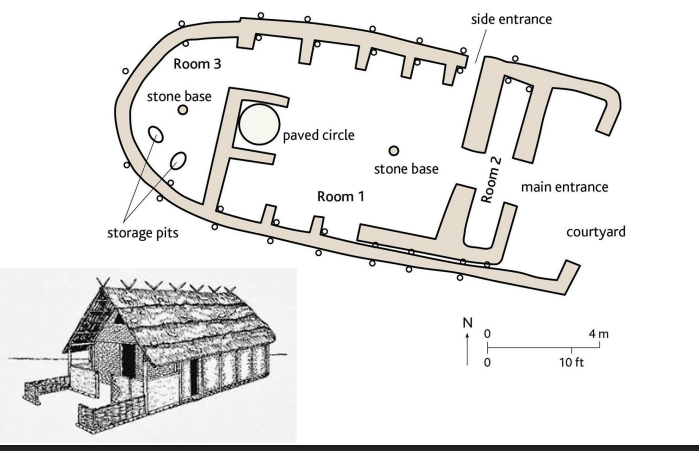
Plan of a probable ruler’s dwelling (basileos) at Nichoria
975 - 800 BC
When the king is removed, the kings house becomes the religious part of the community and as cities developed a lot of the houses of the king become the location of temples
Elements of Greek Sanctuaries
Altar
Where offerings of food would be given
during special events animal would be sacrificed
The animals would be eaten
The altar was the most central and important part of the sanctuary
Temple
storage of the wealthiest and most important items, a treasury
would make artworks out of gold and offer it to the gods
on days of worship, the doors would be open in order for the cult statue to be seen
there were no windows
People did not worship in the temple
was considered the house of the god
It would have a cult statue of the gods and any offerings made to the gods
was the monumentialization of the altar
Temenos
"The sacred space" or “the boundary"
demarcated the mundane from the sacred
Greek Religion
in Greek religion there is an understanding of reciprocity
at this point of time, it wasn't a personal relationship
it was about having the right relationship with the gods
Greek Sanctuaries
Patron deity of polis often had sanctuary on acropolis
Temple of Athena at Athens
Temple of Hera at Argos
Temple of Apollo at Eretria
Sanctuaries were built on the borderlands of cities
would have one on the east and the west
Corinthian sanctuary of Poseidon at Isthmia
Corinth’s Sanctuary at Isthmia allowed them to control the entire Isthmus
eventually become a pan-hellenic sanctuary
Corinthian sanctuary of Hera at Perachora
Corinth’s Sanctuary at Perachora allowed them to control the Corinthian Gulf
acropolis
the highest point of the city
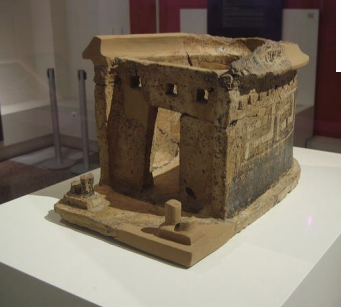
Apsidal House or Temple
early 8th c. BC
Perachora near Corinth
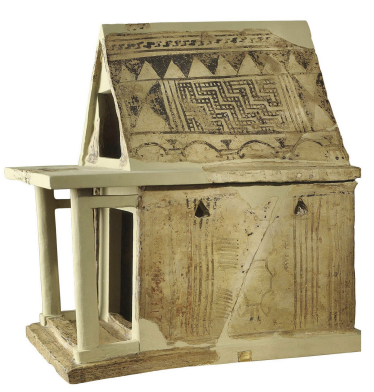
Rectilinear clay temple model from the sanctuary of Hera near Argos
late 8th century BC
Meaning of painted patterns
decorative?
architectural features?
religious symbols?
Interstate Sanctuaries
what happened there
athletic competitions
chariot racing, foot races
oracles ("binding arbitration") were found here
Also worked as arbiters for private matters but also polis matters
These pronouncements would be made by a woman
the breeks believed that women were closer to nature and more easily able to channel the gods
were places where the elite would show off their wealth and status
before the elite would focus their wealth into their family burials
with the invention of the polis, their wealth is invested into votives and offerings at sanctuaries
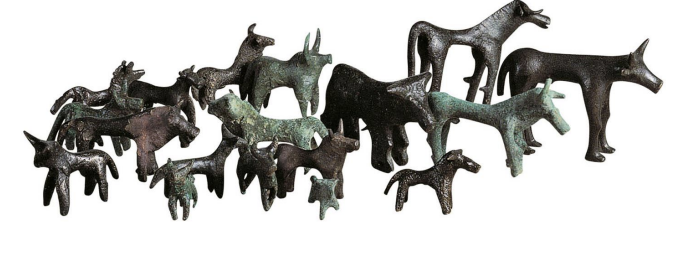
Bronze animal figurines from the sanctuary of Zeus at Olympia
Votives
mostly 8th century BC
The Greeks called these offerings agalma -"delight", because they were a delight to the gods
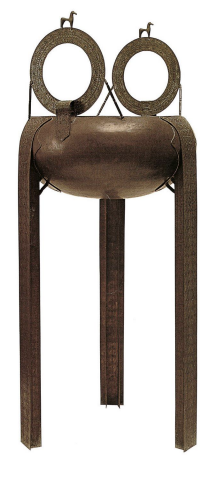
Tripod
Another type of votive offering that emerges is the tripod cauldron
was a victory prize in the funeral games in Homer
served as gift exchange and votives in sanctuaries
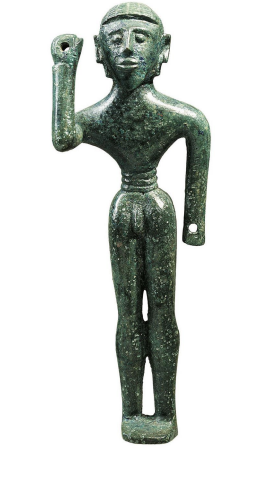
"Smiting" bronze figure from the handle of a tripod from Olympia
8th cent .BC
don't know if it represented a god or a mortal
appear to be related to other "smiting" got statues from the near east
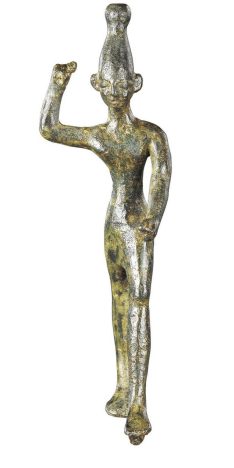
Bronze Semetic "smiting" god
9-8th cent. BC
Wearing an Egyptian crown
The Semitic stautes have clothes but the Greek are nude
more natural looking
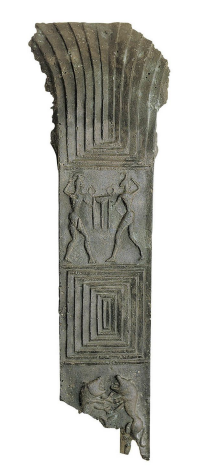
Part of a leg of a tripod from Olympia
8th cent. BC
upper panel: two males dueling over a tripod
In later Greek art, this scene would represent a fight between Apollo and Herakles for the sacred tripod at Delphi
Does this early scene illustrate that myth," Or was the myth invented to make sense of enigmatic scenes like this one
Ekphrasis
Ekphrasis
vividly pictorial literary description of an image in verse or prose
ex. The shield of Achilles in the Illiad
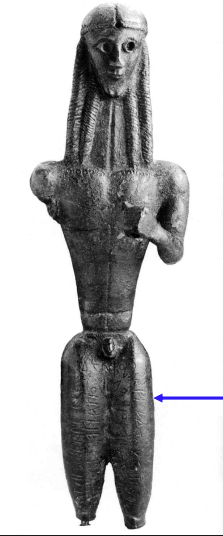
Mantiklos Apollo from Thebes
c. 700 BC
Daedalic Style
named after Daedalus, the first style found on Crete
The body is triangular and cylindrical
eyes are open, wide, and large
rigid
the hair is ordered and patterned
A hole in the left hand to hold objects
maybe a silver bow
Inscription: “Mantiklos dedicated me to the far-shooter with the silver-bow who shoots from afar; grant Apollo, something good in return
demonstrated the reciprocal nature of Greek religion
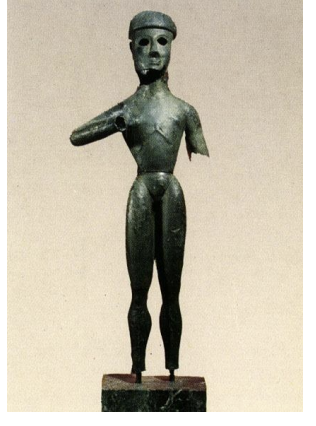
Sphyrelaton technique
taking a bronze sheet and hammering it around a wood core
Cult statues of Dreros
700BC
Phoenician Alphabet
Greeks adopted the Phoenician alphabet in 8th cent. BC
The alphabet only had consonants
The vowels were assumed
When the Greeks adopted the alphabet, they added vowels
the greeks adopted a writing system in order to write down the Homeric epics
The Greeks were very passionate about poetry
vowels are crucial for hexameter which is used in Homer and other verse
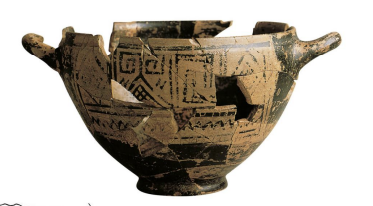
The Nestor Cup
720 BC
Rhodian cop -> made in Rhodes, Late Geometric
Found on the Island of Ischia in the Bay of Naples -> Pithekoussai
Inscription: I am the cup of Nestor, good to drink from Whoever drinks from me will at
once be seized by the desire of fair-crowned Aphrodite
Pithekoussai on Ischia (Italy),
775-750 BC
Earliest known Greek colony beyond the Aegean
Greek Colonization
Spain, North Africa, Italy, Southern France, Black Sea
The colonization that happened was the result of military power → use of the phalanx
There was no open land → the land was inhabited or controlled by communities
The colonies were not on the interior but rather on the coastal, strategic areas
The Greeks had to impose themselves
They fought over the land or when they arrived the locals had to decide whether they were going to contest them
Created a new kind of circumstance
The Greeks are faced with the contrast of the local people
They were influenced by these cultures, and a new form of Greek culture emerged
Acculturation and fusion
New ideas of what it means to be Greek